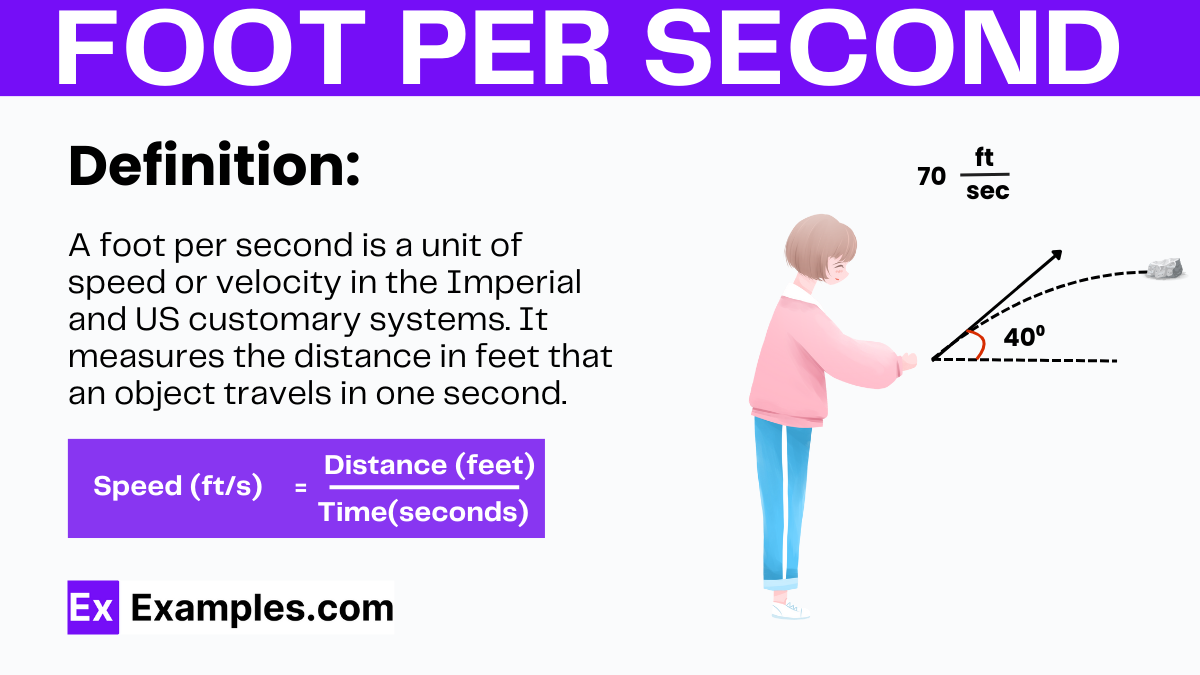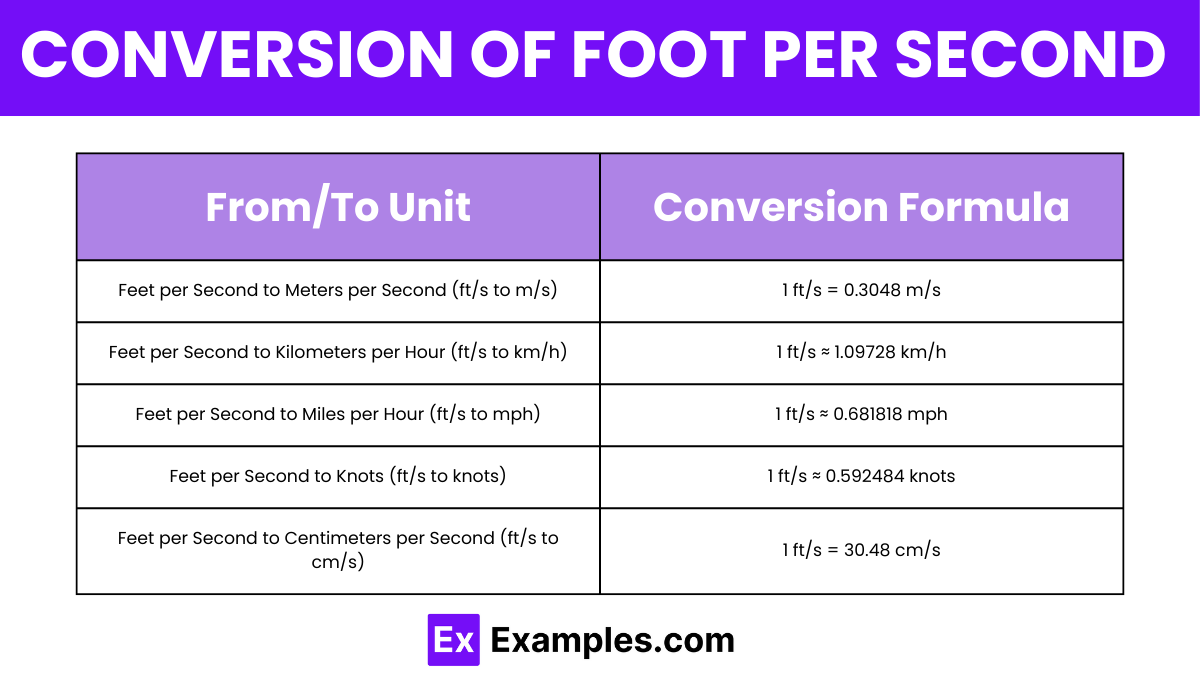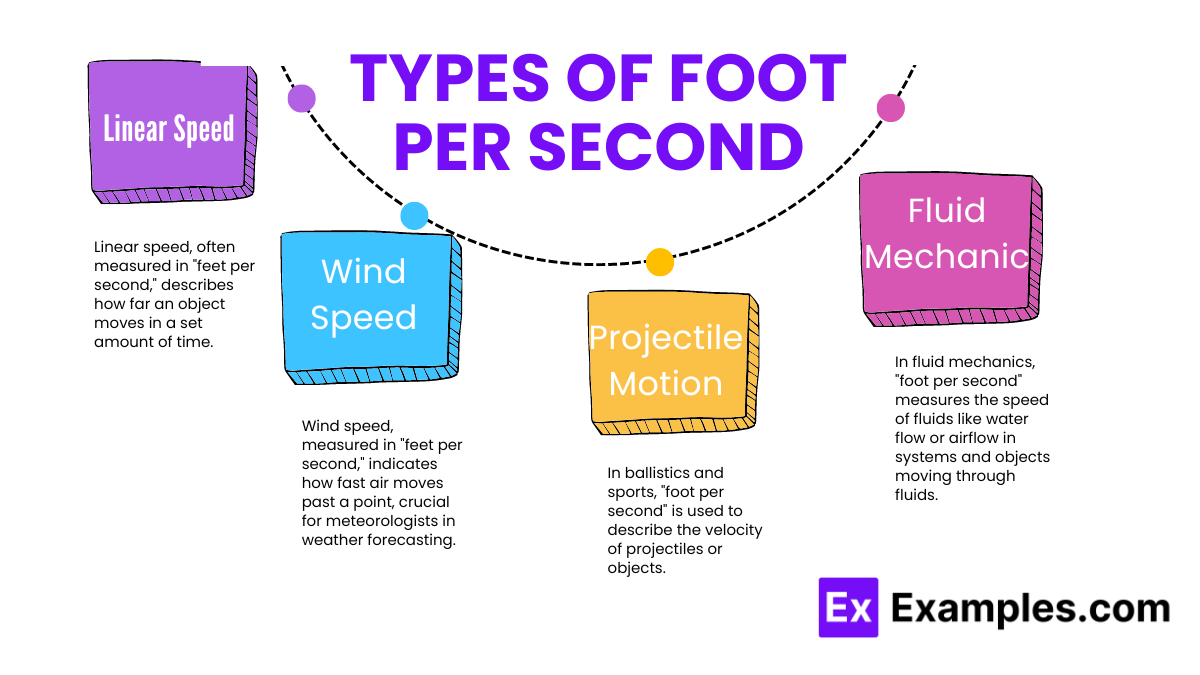What is the unit symbol for foot per second?
ft/s
fps
fts
f/s


The formula to calculate speed in feet per second (ft/s) is:
Where:
For example, if an object travels a distance of 50 feet in 5 seconds, the speed would be calculated as:
Speed = 50 feet/seconds = 10 ft/s

| From/To Unit | Conversion Formula |
|---|---|
| Feet per Second to Meters per Second (ft/s to m/s) | 1 ft/s = 0.3048 m/s |
| Feet per Second to Kilometers per Hour (ft/s to km/h) | 1 ft/s ≈ 1.09728 km/h |
| Feet per Second to Miles per Hour (ft/s to mph) | 1 ft/s ≈ 0.681818 mph |
| Feet per Second to Knots (ft/s to knots) | 1 ft/s ≈ 0.592484 knots |
| Feet per Second to Centimeters per Second (ft/s to cm/s) | 1 ft/s = 30.48 cm/s |
1 Foot Per Second (ft/s) = 0.3048 Meters per Second (m/s)
Converting 1 foot per second (ft/s) to meters per second (m/s) yields exactly 0.3048 m/s, a useful conversion for scientific, engineering, and practical speed measurements.
1 Foot Per Second (ft/s) ≈ 1.09728 Kilometers per Hour ( km/h)
Converting 1 foot per second (ft/s) results in approximately 1.09728 kilometers per hour (km/h), which is useful for understanding speeds in contexts that use the metric system.
1 Foot Per Second (ft/s) ≈ 0.681818 Miles per Hour (mph)
Converting 1 foot per second (ft/s) to miles per hour results in approximately 0.681818 mph, a conversion useful for understanding speeds in everyday contexts such as driving.
1 Foot Per Second (ft/s) ≈ 0.592484 Knots ( knots)
Converting 1 foot per second (ft/s) to knots results in approximately 0.592484 knots. This conversion is essential for applications in navigation and maritime speed measurements.
1 Foot Per Second (ft/s) = 30.48 Centimeters per Second ( cm/s)
Converting 1 foot per second (ft/s) to centimeters per second results in exactly 30.48 cm/s, providing a metric measurement for speed useful in various scientific contexts.

The abbreviation for “feet per second squared” is “ft/s².” It represents the rate of change of velocity over time in feet per second squared, commonly used in physics and engineering equations describing acceleration.
To convert feet per second to miles per hour, multiply the speed in feet per second by 0.681818. This conversion factor accounts for the difference in unit lengths between feet and miles.
ft/s” stands for “feet per second,” a unit of speed representing the distance traveled in feet during one second, commonly used in physics, engineering, and meteorology.
To convert foot per second to meters per second, multiply the speed in feet per second by 0.3048. This conversion factor accounts for the difference in unit lengths.
Text prompt
Add Tone
10 Examples of Public speaking
20 Examples of Gas lighting
What is the unit symbol for foot per second?
ft/s
fps
fts
f/s
Convert 10 feet per second to meters per second (1 foot = 0.3048 meters).
3.048 m/s
0.3048 m/s
30.48 m/s
0.03048 m/s
If an object is traveling at 20 feet per second, what is its speed in miles per hour? (1 mile = 5280 feet)
15.12 mph
13.64 mph
11.36 mph
12.27 mph
How many inches per second is equivalent to 5 feet per second? (1 foot = 12 inches)
50 inches per second
30 inches per second
40 inches per second
60 inches per second
A car is moving at 88 feet per second. What is this speed in kilometers per hour? (1 foot = 0.3048 meters, 1 kilometer = 1000 meters)
96.5 km/h
97.1 km/h
104.5 km/h
102.3 km/h
If a runner covers a distance of 50 feet in 5 seconds, what is their speed in feet per second?
15 ft/s
20 ft/s
5 ft/s
10 ft/s
How many feet per second are in 10 miles per hour? (1 mile = 5280 feet)
14.67 ft/s
15.3 ft/s
13.2 ft/s
10.5 ft/s
If a person walks at a speed of 4 feet per second, how many feet will they cover in 30 seconds?
120 feet
150 feet
180 feet
160 feet
What is the acceleration in feet per second squared if the speed of an object increases from 0 to 60 feet per second in 10 seconds?
5 ft/s²
6 ft/s²
4 ft/s²
8 ft/s²
Convert 25 feet per second to meters per second.
7.62 m/s
8.1 m/s
7.25 m/s
7.83 m/s
Before you leave, take our quick quiz to enhance your learning!

